Laser vs DLP vs LCD vs LED vs LCoS: Shedding Light on Projector Technology
25-06-2019 | By Moe Long
Projectors aren’t exactly new. Existing in a variety of forms, from 35mm film projectors to slide projectors and even overhead projectors, these devices offer a means of casting a large image on virtually any surface. Digital projectors come in various forms, and with increasingly affordable projectors, they have seen further adoption outside classrooms, theatres, and conference rooms. But like panel televisions which range from LCD and LED to plasma, projectors utilise different projection technology. Learn about DLP vs LCD vs LED in projectors!
Projector Technology Comparison: DLP vs LCD vs LED vs LCOS - A Closer Look
In the world of digital projection, there are four main projector technologies: DLP, LCD, LED, and LCOS. DLP stands for Digital Light Processing which employs a chip comprised of microscopic mirrors and a spinning colour wheel to generate an image. LCD projectors opt for liquid crystal displays rather than physical moving parts, as you’ll find in DLP projectors. LED projectors, or light-emitting diode projectors, are a bit of a different breed. These are either DLP or LCD technologies but tout LED light sources. LCoS, on the other hand, stands for liquid crystal on silicon and is a sort of DLP-LCD hybrid which uses liquid crystal chips and a mirrored backing. Then, there are laser projectors which differ from lamp-based projectors by opting for a solid-state laser rather than a lamp for its light source.
What is a DLP Projector, and What are the Benefits of DLP Projection?
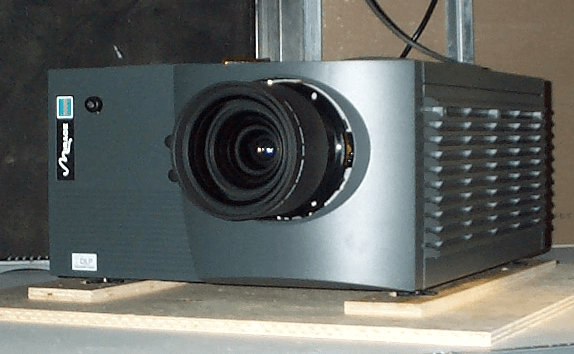 Image source: en.wikipedia.org
Image source: en.wikipedia.org
A DLP, or digital light processing, the projector uses tiny mirrors, which in turn reflect light toward a screen. There’s typically a physical colour wheel, which is a literal spinning wheel full of colour filters used to generate sequential colours. These can be found as single-chip DLP projectors or three-chip DLP projectors with red, green, and blue DLP chips. Prices vary from hundreds of pounds to tens of thousands. DLP projectors are easily the most common, with most home theatre projectors utilising DLP technology.
Light output on DLP projectors tends to be robust and suitable for atmospheres with ambient light, such as classrooms and conference rooms. Likewise, colour accuracy, while varying quite a bit by device, often shines with DLP projectors. Motion blur isn’t a huge issue on most DLP projectors, with crisp, sharp images during fast-motion sequences in action flicks and sports. However, DLP projectors may be plagued with rainbow artifacts where bright objects may give off the appearance of a sort of light trail. This doesn’t affect three-chip DLP projectors, but single-chip DLP projectors might experience artifacting.
Types of DLP (Digital Light Processing) projectors:
- Single-chip DLP: This type of DLP projector uses a single DMD (digital micromirror device) to create an image. It is the most common type of DLP projector, known for its high image quality and fast response time.
- Three-chip DLP: This type of DLP projector uses three DMDs (one for each primary colour: red, green, and blue) to create an image. It is known for its high colour accuracy and brightness.
- 4K DLP: This type of DLP projector uses a DMD with a high resolution of 4,096 x 2,160 pixels to create an image. It is known for its high image quality and fine details.
- Short-throw DLP: This type of DLP projector is designed for use in small spaces and can project a large image from a short distance.
- Portable DLP: This type of DLP projector is small and lightweight, making it easy to transport and set up. It is perfect for presentations on the go.
- Interactive DLP: This type of DLP projector is equipped with interactive features such as a touch screen, stylus and finger touch, which allows the user to interact with the projected image.
Pros:
- High image quality: Known for producing sharp, detailed images with excellent colour accuracy.
- High colour accuracy (varies by device)
- Minimal motion blur: Digital micromirror device allows for fast switching of pixels, which means that fast-moving images or video can be displayed with minimal motion blur.
- Fast response time: DLP projectors have fast response times, which makes them a good choice for displaying fast-moving images or video.
- Durability: Built with durable components, making them less susceptible to damage from heat or vibration.
- Compact and lightweight: Typically smaller and lighter than other types of projectors, making them easy to transport and set up.
- Low maintenance: Don't require frequent bulb replacements like some other types of projectors, which can save on maintenance costs over time.
Cons:
- Limited brightness: May not be as bright as other types of projectors, which can make them less suitable for large rooms or brightly lit environments.
- Limited colour gamut: May not produce as wide a range of colours as other types of projectors, which can lead to less accurate and less vibrant images.
- Rainbow effect: Can produce a rainbow effect, where a rainbow pattern is seen on the screen, particularly when the viewer is moving their eyes around the screen quickly. This effect can be bothersome for some people.
- Colour wheel replacement: DLP projectors use a colour wheel which may need to be replaced if it fails. This can be more expensive and time-consuming than replacing a lamp in other projectors.
- Limited zoom and lens shift: DLP projectors typically have limited zoom and lens shift capabilities, which can make it difficult to adjust the image size and position.
What is an LCD Projector, and What are the Benefits of LCD Projection?
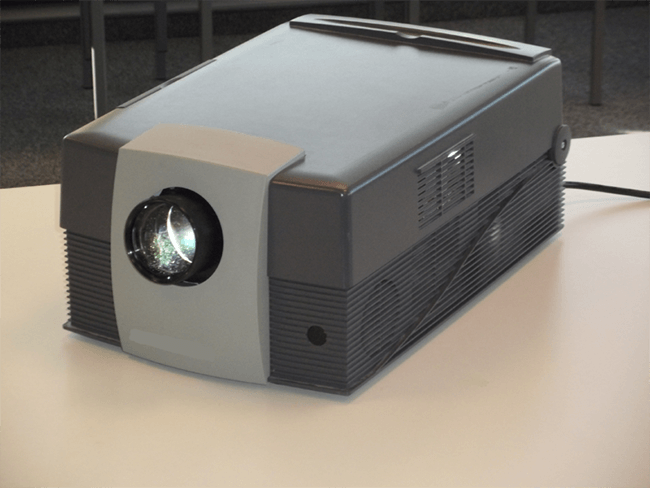
Image source: en.wikipedia.org
While LCD, or liquid crystal display, technology is common in TVs and computer monitors, it’s also popular in the projection space. LCD projectors feature three LCD panels which cast an image using a primary colour: red, blue, and green. All three are simultaneously projected to display the resulting image in its full colouring. Price varies quite a bit, from a few hundred to the upper thousand.
Generally, LCD projectors are pretty inexpensive to operate since they eschew moving parts. Lamp life is generally much higher than with DLP projectors. Colour accuracy is top-notch, and there’s pretty low power consumption. Black levels shine, and light output or lumens can be pretty high. Rainbow artifacts are kept to a minimum, though motion blur may be an issue.
Types of LCD (Liquid Crystal Display) projectors:
- Home theatre projectors: Designed for use in home theatres and are known for their high image quality and excellent black levels.
- Business projectors: Designed for use in business settings such as conference rooms and classrooms. They are known for their high brightness and excellent colour accuracy.
- Portable projectors: Small and lightweight, making them easy to transport and set up. They are perfect for presentations on the go.
- Short-throw projectors: Designed for use in small spaces and can project a large image from a short distance.
- Interactive projectors: Equipped with interactive features such as a touch screen, stylus and finger touch, which allows the user to interact with the projected image.
Pros:
- Image quality: LCD projectors produce bright, clear images with accurate colours and good contrast.
- Low maintenance: LCD projectors have a long lamp life and do not require frequent bulb replacements like other types of projectors.
- Excellent black levels: LCD projectors are known for their excellent black levels. This means that they are able to produce deep, rich blacks, which helps to enhance the overall contrast and detail of the image.
- Low noise: Many LCD projectors are designed with low-noise fans, which means they operate quietly and won't be a distraction during presentations.
- High light output: LCD projectors are known for their high light output. This means that they can produce bright images even in large rooms or brightly lit environments.
- Minimal rainbow artifacts: LCD projectors are less likely to produce rainbow artifacts than other types of projectors, such as DLP projectors.
- Inexpensive to operate: One of the benefits of using an LCD (Liquid Crystal Display) projector is that they are relatively inexpensive to operate.
Cons:
- Motion blur may be an issue: One of the downsides of using an LCD projector is that motion blur may be an issue. LCD projectors have a slower response time than other types of projectors, which can cause fast-moving images or video to appear blurry.
- Limited contrast ratio: LCD projectors may produce a lower contrast ratio than other types of projectors, which can result in less detailed images.
- Limited colour gamut: LCD projectors may not produce as wide a range of colours as other types of projectors, which can lead to less accurate and less vibrant images
- Limited zoom and lens shift: LCD projectors typically have limited zoom and lens shift capabilities, making it difficult to adjust the image size and position.
- Image distortion: LCD projectors can produce distortion or the "screen door effect", where the pixels of the image are visible, particularly when the projector is not positioned correctly.
What is an LED Projector, and What are the benefits of LED Projection?
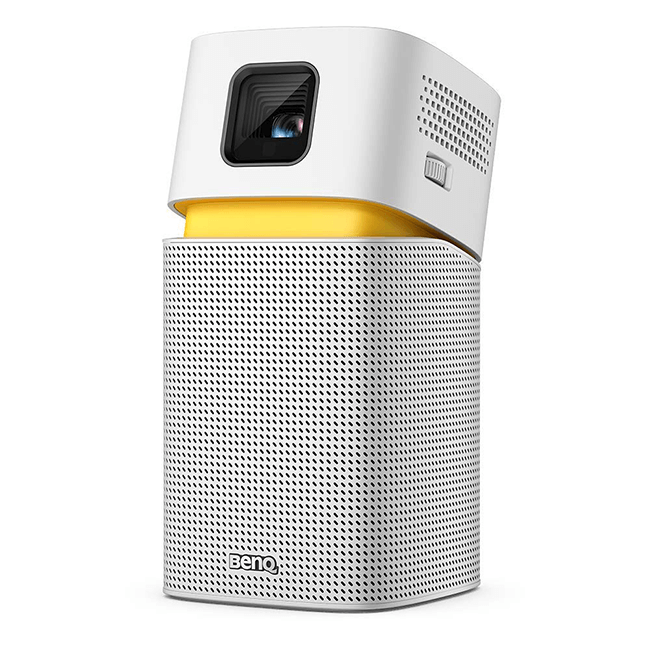
Image source: www.amazon.com
"LED" is a term commonly used in lighting technology to refer to light-emitting diodes. However, in the context of projectors, "LED" typically refers to the type of light source used rather than the technology used for projection. It's worth noting that projectors that are labelled as "LED" can use either DLP (Digital Light Processing) or LCD (Liquid Crystal Display) technology to project the image. Unlike traditional lamp-based projectors, LED projectors use high-efficiency bulbs that substantially increase lamp life. The typical lamp life of most projectors is 1,000-5,000 hours, while LED projectors have a lamp life of upwards of 20,000 hours. The cost of LED projectors can vary, similar to LCD and DLP projectors. The quality of the image, including black levels, motion blur, colour accuracy, and artifacting, depend on the underlying projection source, whether it is DLP or LCD. However, maintenance of LED projectors is minimal due to their filterless design and long lamp life. The BenQ GV1 and ZTE Spro2 are examples of LED devices that use an LED light source and DLP projection technology.
Types of LED (Light-Emitting Diode) projectors:
- Pico projectors: These projectors are small and portable, making them easy to take on the go. They are known for their high brightness and excellent colour accuracy.
- Pocket projectors: These projectors are small and lightweight, making them easy to transport and set up. They are perfect for presentations on the go.
- Portable projectors: These projectors are small and lightweight, making them easy to transport and set up. They are perfect for presentations on the go.
- Short-throw projectors: These projectors are designed for use in small spaces and can project a large image from a short distance.
Pros:
- Long life: LED projectors have a longer life than traditional lamp-based projectors (often 20,000 hours), which means they do not require frequent bulb replacements.
- Energy efficient: LED projectors use less power than traditional lamp-based projectors, which means they are more energy efficient and have lower operating costs.
- Bright and vivid colours: LED projectors produce bright and vivid colours, which makes them perfect for presentations and video playback.
- High brightness: LED projectors are known for their high brightness, which makes them suitable for use in large rooms or brightly lit environments.
- May be DLP or LCD: LED projectors can be based on either DLP (Digital Light Processing) or LCD (Liquid Crystal Display) technology.
- Almost maintenance-free: One of the benefits of using an LED projector is that they are almost maintenance-free. Unlike traditional lamp-based projectors, LED projectors have a long life and do not require frequent bulb replacements.
Cons:
- Higher initial cost: LED projectors tend to have a higher initial cost compared to traditional lamp-based projectors.
- Limited zoom and lens shift: LED projectors typically have limited zoom and lens shift capabilities, which can make it difficult to adjust the image size and position.
- Not suitable for 3D: Some LED projectors may not support 3D content, as well as other types of projectors.
What is an LCoS Projector, and What are the Benefits of LCoS Projectors?
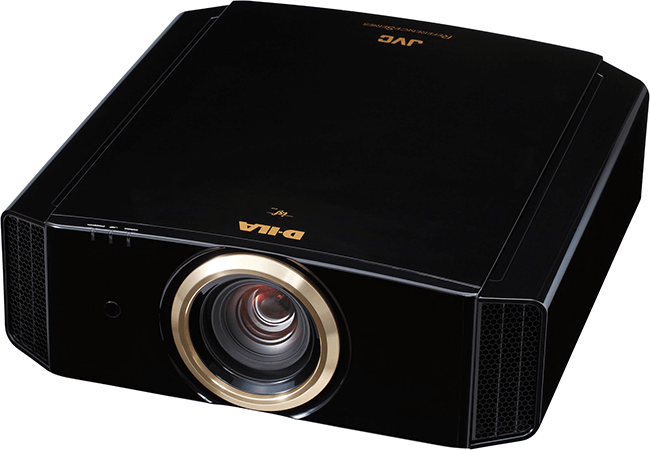
Image source: upload.wikimedia.org
LCoS, or liquid crystal on silicon, arrives as a sort of LCD-DLP hybrid fusion. At its core, LCoS employs liquid crystal chips with reflective backing similar to DLP. However, an LCoS projector passes light through LCD panels which is then modulated by liquid crystals. Therefore, it’s at once a reflective technology and one which opts for LCDs rather than mirrors. There’s extremely high resolution, and SVGA LCoS projectors don’t even exist. Yet this comes at a cost: weight. The lightest LCoS projectors clock in a bit over 10 pounds. DLP, LCD, and LED projectors are far more portable. The likes of JVC and Sony use proprietary LCoS tech, D-ILA and SXRD, respectively. I’ve got a hulking Sony VPL-VW60 home theatre projector with LCoS technology onboard, and, while not nearly as portable as my ZTE Spro2 or BenQ GV1, the VPL-VW60 delivers top-tier image quality with lush colour reproduction and gorgeous black levels. Usually, the price is a bit higher, mostly in the thousands.
There’s a reason videophiles flock to LCoS projectors, and contrast ratio, an important image quality spec, proves why. Performance is superb; likewise, black levels are incredible with deep blacks and bright whites. Light output can vary, with many older LCoS projectors offering pretty low lumens and newer LCoS sets yielding high light output. Unfortunately, motion blur, as with LCD projectors, may be an issue, though there’s almost no rainbow artifacting.
Types of LCoS (Liquid Crystal on Silicon) projectors:
- 4K projectors: These projectors have a high resolution of 4,096 x 2,160 pixels and are known for their high image quality and fine details.
- 3D-enabled projectors: These projectors are capable of displaying 3D content and are equipped with the necessary technology, such as active or passive 3D glasses.
- High-end projectors: These projectors are designed for professional use and come with advanced features such as dual LCoS panels and advanced lens systems.
- Interactive projectors: These projectors are equipped with interactive features such as a touch screen, stylus and finger touch, which allows the user to interact with the projected image.
- Business projectors: These projectors are designed for use in business settings such as conference rooms and classrooms. They are known for their high brightness and excellent colour accuracy.
- Home theatre projectors: These projectors are designed for use in home theatres and are known for their high image quality, excellent black levels and high contrast ratio.
- Portable projectors: These projectors are small and lightweight, making them easy to transport and set up. They are perfect for presentations on the go.
Pros:
- Excellent image quality: LCoS (Liquid Crystal on Silicon) projectors are known for their superb image quality. They use a combination of liquid crystal and silicon to produce bright, clear, and vibrant images.
- Great black levels: LCoS projectors are known for their excellent black levels. This means that they are able to produce deep, rich blacks, which helps to enhance the overall contrast and detail of the image.
- Superb contrast ratio: LCoS projectors have a high contrast ratio that provides excellent image quality. This makes them perfect for use in settings such as home theatres, video playback and photography applications.
- Varying light output: LCoS projectors have varying light output, which can be adjusted to suit the ambient lighting conditions of the room.
- Little to no rainbow artifacting: LCoS projectors are less likely to produce rainbow artifacts than other types of projectors, such as DLP projectors. This means that the images produced by LCoS projectors are less likely to be affected by rainbow patterns, which can distract some viewers.
Cons:
- Some motion blur: LCoS projectors have a slower response time than other types of projectors, which can cause fast-moving images or videos to appear blurry. This is more pronounced when viewing sports or gaming.
- High cost: LCoS projectors tend to be more expensive than other types of projectors, making them less accessible for some consumers.
- Limited availability: LCoS projectors are less widely available than other projectors, making it more difficult to source.
What is a Laser Projector, and What Are the Benefits of Laser Projection?
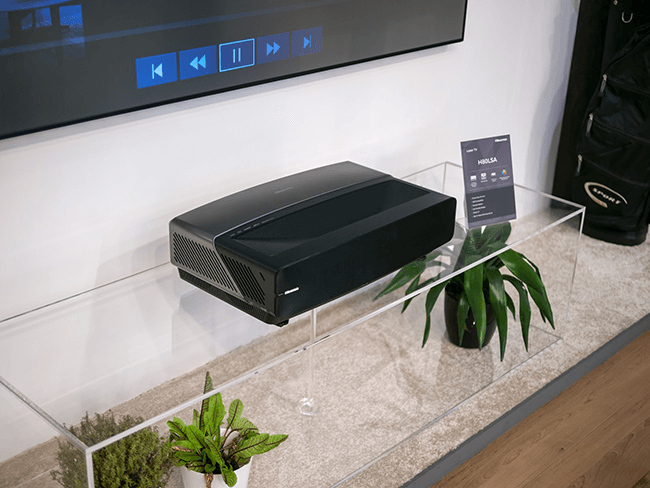
Image source: upload.wikimedia.org
Traditionally, lamps provide a light source for projectors, and this remains true of DLP, LCD, LED, and LCoS projectors. However, lasers are beginning to replace lamps in projectors and may be the future of projection. Image quality is fantastic, arguably trouncing even LCoS, and lasers last longer than even energy-efficient LED bulbs. Moreover, lasers are more durable than traditional projector bulbs, delivering almost instantaneous on-off functionality. Like an LED projector, a laser projector still uses an LCD, DLP, or LCoS chip and speaks of the light source rather than the projection technology itself.
While a standard bulb-centric projector uses RGB lighting to reproduce colours on the screen, a laser projector instead generates the precise colours needed for a picture. As such, it’s more energy-efficient, and this even allows a laser projector to get extremely bright, far brighter than DLP, LCD, or LCoS units. Ok, so what’s the catch? Price. Laser projectors are costly, retailing for several thousand at minimum.
Types of Laser (Laser Light Source) projectors:
- FB4 lasers: FB4 lasers are a type of laser projector that uses an FB4 laser light source. This type of projector is compact and suitable for applications such as portable events, bars, and nightclubs.
- ILDA lasers: ILDA lasers are a type of laser projector that uses an ILDA laser light source. This type of projector is suitable for applications such as large-scale shows, professional events, and festivals.
- DMX lasers: DMX lasers are a type of laser projector controlled by a DMX protocol. This type of projector is suitable for applications such as live shows, concerts, and theatrical productions.
- Gobo projectors: Gobo projectors are a type of laser projector that projects images or patterns onto a wall or surface. This type of projector is suitable for applications such as logo projection, mapping, and special effects.
- Projectors for office and education: Projectors for office and education are a type of laser projector that is designed for presentations and teaching. This type of projector is suitable for applications such as classrooms, boardrooms, and corporate events.
- Home theatre projectors: Home theatre projectors are a type of laser projector designed for home entertainment. This type of projector is suitable for applications such as movie nights, video game sessions, and sports events.
- Fiber-fed projectors: Fiber-fed projectors are a type of laser projector that is fed by a fiber light source. This projector type is suitable for large-scale displays, architectural projections, and theme park attractions.
- Laser phosphor: Laser phosphor projectors are a type of laser projector that uses a laser phosphor light source. This type of projector is suitable for applications such as digital signage, retail displays, and projection mapping.
- RB laser and RGB laser: RB laser and RGB laser projectors are a type of laser projector that uses an RB laser or RGB laser light source. This type of projector is suitable for applications such as live events, concerts, and multimedia shows.
Pros:
- Extremely bright: Laser projectors are known for their incredibly bright and vivid images, making them great for use in large venues.
- Fantastic colour reproduction: Laser projectors offer stunningly accurate colours that can create lifelike images.
- Great black levels: Laser projectors offer deep and true black levels, which can create a more immersive visual experience.
- Superb contrast ratio: Laser projectors have a high contrast ratio, making them great for viewing in darker rooms.
Cons:
- Very expensive: Laser projectors are typically more costly than traditional lamp-based projectors, making them a less attractive option for people on a tighter budget.
DLP vs LCD vs LED vs LCoS vs Laser: Shedding Light on Projector Technology
Ultimately, selecting a projector depends on several factors, notably budget. DLP, LCD, and LED projectors are pretty common and vary from sub-$100 budget projectors to several thousand dollar devices. LCoS boasts videophile-calibre image quality at the expense of cost. Laser projectors present the best image available from a projector but are too costly for mainstream adoption.

